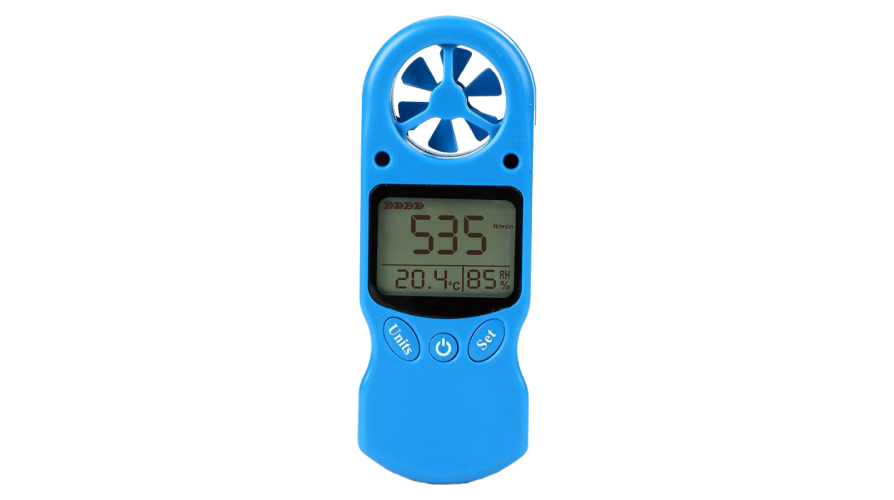How to Preserve and Care for Your Anemometer to Guarantee Longevity
How to Preserve and Care for Your Anemometer to Guarantee Longevity
Blog Article
All You Required to Learn About Anemometers: Exactly How They Work, Why They Issue, and Where to Make use of Them
Anemometers, however usually forgotten in the world of scientific tools, play a vital role in various areas, offering important insights right into wind speed and air movement patterns. Comprehending the technicians behind these gadgets is important for any person seeking to harness the power of this information. From meteorologists tracking weather condition patterns to engineers creating frameworks with wind loads in mind, the applications of anemometers are diverse and significant. As we explore the complexities of anemometer modern technology, we will discover the inner functions of these gadgets, their importance, and the crucial factors to consider when selecting the appropriate anemometer for particular applications.

Anemometer Fundamentals
A vital instrument made use of to gauge wind speed and instructions, the anemometer plays a vital role in weather forecasting and different industries. An anemometer commonly is composed of 3 or four mugs that revolve in the wind, a vane that aims right into the wind, and sensing units to track the activities or turnings.
There are numerous kinds of anemometers available, consisting of cup anemometers, vane anemometers, hot-wire anemometers, and sonic anemometers, each with its one-of-a-kind functions and applications. Cup anemometers are commonly utilized for fundamental wind rate measurements, while vane anemometers are chosen for directional dimensions.
Concepts of Anemometer Procedure
Building on the foundational understanding of anemometer basics, the principles of anemometer operation illuminate the mechanics behind wind speed and direction dimensions. Anemometers operate the concept of air movement impacting a sensor, creating it to revolve. Mug anemometers, for example, have 3 or more cups that capture the wind, triggering them to spin faster as the wind speed increases. The turning rate is after that transformed right into a wind rate measurement. Vane anemometers, on the other hand, utilize a tail or a probe that aligns itself with the wind instructions, providing a measurement of wind direction based upon the positioning of the sensing unit. Hot-wire anemometers depend on a warmed cable that cools off as wind overlooks it, with the price of cooling figuring out the wind rate. Ultrasonic anemometers procedure wind rate and instructions by examining the time it takes for ultrasonic signals to take a trip in between transducers. Comprehending these principles is vital for exact and trustworthy wind dimensions in numerous applications.
Value of Anemometers
The value of anemometers in meteorology and numerous industries can not be overstated. Anemometers play a crucial duty in determining wind rate and instructions, supplying important data for climate forecasting, environment studies, environmental surveillance, and air travel procedures. Meteorologists depend on anemometers to gather exact wind data, assisting them understand weather condition patterns, predict storms, and problem prompt warnings to the public. In sectors such as construction, farming, renewable power, and maritime procedures, anemometers are utilized to enhance procedures, ensure security, and increase effectiveness. As an example, wind farm operators make use of anemometers to evaluate wind problems and make the most of power production from wind turbines. In the maritime see here sector, anemometers help ship navigating by providing real-time wind information to captains, helping them make educated choices to ensure safe voyages. Generally, anemometers are important devices that contribute significantly to safety and security, performance, and educated decision-making in weather forecasting and a wide variety of sectors.
Applications Across Various Industries
Applications of anemometers extend across diverse sectors, showcasing their adaptability and utility past meteorology. In the renewable resource industry, anemometers play an essential function in examining wind conditions for wind ranch placements, making certain optimum energy manufacturing. Industries like building and mining make use of anemometers to check wind rates, essential for safety and security procedures, specifically when working at elevations or in open-pit mines where strong winds can present hazards. Anemometers are also integral in the aeronautics industry, helping pilots in comprehending airspeed and wind direction for safe take-offs and touchdowns. The maritime sector take advantage of anemometers for ship navigation, helping sailors anticipate weather condition adjustments and adjust paths accordingly. In agriculture, anemometers aid farmers in managing crop spraying by giving real-time data on wind speed to prevent drift. In addition, anemometers discover applications in cooling and heating systems to optimize air flow and improve energy effectiveness in buildings. The diverse use cases of anemometers highlight their relevance across various industries, highlighting their important duty in this article enhancing operational safety and efficiency (anemometer).

Choosing the Right Anemometer for Your Requirements
Picking the appropriate anemometer customized to your details requirements is vital for obtaining exact wind rate and instructions dimensions. When choosing an anemometer, consider aspects such as the desired application, called for dimension range, environmental conditions, and desired functions. For general objectives, a cup anemometer is suitable for determining wind speed, while a vane anemometer offers wind direction information. Hot-wire anemometers are optimal for reduced airspeed dimensions, and ultrasonic anemometers supply high precision and resilience.

Final Thought
In verdict, anemometers play an important duty in measuring wind speed and direction throughout numerous industries. It is vital to think about the significance of anemometers in order to make educated choices when picking the most appropriate gadget for gauging wind conditions.
There are different kinds of anemometers readily available, including mug anemometers, vane anemometers, hot-wire anemometers, and sonic anemometers, each with its unique features and applications. Cup anemometers are frequently used for fundamental wind rate dimensions, while vane anemometers are preferred for directional measurements. Hot-wire anemometers are suitable for our website low airspeeds, and sonic anemometers are suitable for high-precision dimensions in study and industrial setups.Structure on the fundamental understanding of anemometer basics, the principles of anemometer procedure clarify the mechanics behind wind speed and direction measurements. For basic purposes, a cup anemometer is appropriate for determining wind speed, while a vane anemometer offers wind direction data.
Report this page